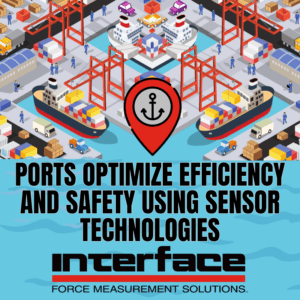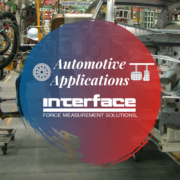Seaside Ports are Optimizing Efficiency and Safety Using Interface Sensor Technologies
 Among the various maritime sectors, Interface supplies measurement solutions to infrastructure and equipment makers for ports and waterway terminals that heavily rely on quality measurement solutions.
Among the various maritime sectors, Interface supplies measurement solutions to infrastructure and equipment makers for ports and waterway terminals that heavily rely on quality measurement solutions.
Ports are critical to our global economy. An estimated 2,500+ ports exist worldwide, with thousands more harbor entries and waterway commerce centers. Interface offers an extensive line of products commonly used in port and terminal applications of all types to modernize equipment and improve operations.
Interface’s sensors and instrumentation are used to test and confirm product designs and measure real-time functions of equipment used onshore, nearshore, and offshore. Our force measurement products are frequently used for modernizing and maintaining port-related machines, moving equipment, and lifts. This includes our submersible measurement solutions.
Our products are perfect for precise load measurement during lifting operations, cargo handling, cargo weight monitoring, mooring line monitoring, and general port equipment maintenance.
The most common use case for Interface products for container stacking and handling. Load cells are integrated into gantry and reach stacker crane systems that lift and move shipping containers. These devices measure the weight of each container, ensuring safe handling and preventing overloading.
Load cells play a vital role in mooring and anchoring systems. They measure the tension on mooring lines and anchor chains, ensuring they can withstand the forces exerted by wind, waves, and currents. This helps prevent ships from breaking free and protects the vessel and the surrounding infrastructure.
Cargo moving and weighing equipment at ports heavily rely on sensor technologies. Conveyor belts transporting bulk goods utilize load cells to measure the product’s weight accurately.
Many port and terminal crane systems incorporate load cells with built-in safety features to prevent overloading and potential accidents. These devices monitor the applied weight and automatically shut down or limit crane operation if the safe limit is exceeded.
The vehicles entering and leaving port terminals with cargo often pass over weighbridges equipped with load cells. These devices accurately measure the vehicle’s weight, ensuring compliance with weight regulations and preventing damage to infrastructure from overloaded vehicles. Scales using load cells ensure high-accuracy measurement.
Our load cell technologies ensure the safe and efficient operation of various port equipment by measuring the weight, tension, and compression forces exerted on different components, allowing operators to make informed decisions and prevent accidents.
Maritime Port and Terminal Applications Using Interface Products
- Container Weighing
- Ship-to-Shore Crane Load Monitoring
- Ship Stability Testing
- Quick Release Hooks (QRH)
- Mooring Line Tension Monitoring
- Dockside and Terminal Equipment
- Container Handling Machines
- Ship Loader Booms and Unloaders
- Gantry Crane Safety Monitoring
- Straddle Carriers
- Conveyor Belt Design, Test and Measurement
- Reach Stacker Automation
Due to the environment, safety requirements, and regulations for maintaining core operations of ports, quality sensor devices must withstand unpredictable conditions, including complete submersible use cases. Interface plays a vital role as a supplier of measurement solutions designed for maritime use. Our rugged weighing and force measurement products are designed for durable operation in areas that utilize waterways to transport goods from port to port.
We offer submersible products that meet harsh and extreme environmental requirements and are rugged in design. These products include our stainless steel load cells, load pins, load shackles, tension links, and several instrumentation devices.
Mooring Lines Quick Release Hooks
A customer wants to test the strength of the cable line used in the hoist of their vessel. Customers need test their Quick Release Hook (QRH) system when their vessels are docked. They want to ensure the mooring lines are secured and the quick-release hooks can be easily and safely released. Interface’s WTSLP Stainless Steel Load Pin can be installed into the quick release hook, where forces from the mooring lines can be measured and displayed when paired with the WTS-BS-4 USB Industrial Base Station. The WTS-RM1 Wireless Relay Output Receiver Module alarm can also be triggered for the customer when maximum safety workload capacities are reached or overloaded. Learn more here.
Port Reach Stacker Safety
A reach stacker is a vehicle used in shipping ports and container terminals to lift, move, and stack heavy containers. A force monitoring system is needed to ensure the safety of surrounding personnel and to determine if the reach stacker can lift heavy loads. Interface’s WTSLP Wireless Stainless Steel Load Pins can be installed into the corners of the lifting mechanism of the reach stacker, where heavy-loaded containers are lifted and moved. The force results are then transmitted to the WTS-BS-1-HS Wireless Handheld Display for Single Transmitters or directly to the customer’s PC with the WTS-BS-6 Wireless Telemetry Dongle Base Station. Read more.
Crane Capacity Verification
A customer wanted a system to detect if their crane block could lift heavy loads securely to keep working conditions and personnel safe at docks and other maritime transportation applications. If lifting capacities were exceeded, the customer wanted a system to alarm them in real time. Interface’s Model WTSATL-JR Aluminum Compact Wireless Tension Link Load Cell was used to measure the load’s maximum capacity. The WTS-RM1 Wireless Relay Output Receiver Modules also triggered an alarm when the maximum capacity of weight/force was reached. The data was transmitted and could be reviewed with the WTS-BS-1-HS Wireless Handheld Display or on the customer’s PC. Using this solution, the customer verified if the crane is safe and functional enough to lift its working load limit (WLL) or safe working load (SWL) capacity.
Boat Hoist
A customer needed a boat hoist system to lift boats out of water for maintenance. They wanted a wireless solution to monitor the forces being applied through the hoist system. Interface suggested using multiple WTSSHK-B Wireless Crosby™ Bow Load Shackles at the pick-up points of the hoist mechanism. Data results of the individual loading points and total weight were transmitted wirelessly to the WTS-BS-4 Industrial USB Base Station when connected to a PC or laptop with supplied Log100 software. Interface’s wireless system and solution successfully measured the boat’s weight and ensured it would be safely lifted out of the water.
Integrated seamlessly into various port machinery and equipment, Interface measurement devices provide highly accurate, real-time data to save costs, improve productivity, and keep workers and cargo safe during port operations.








